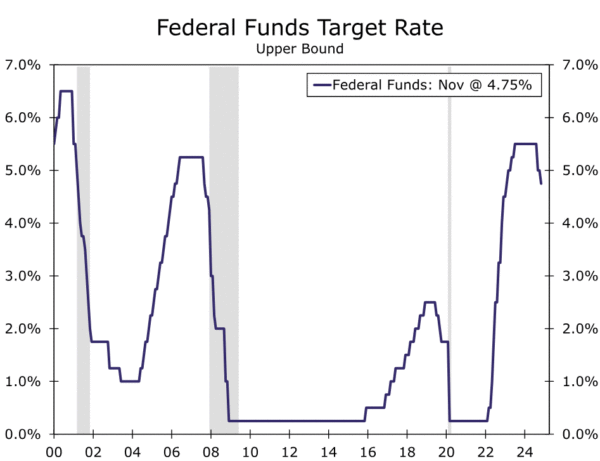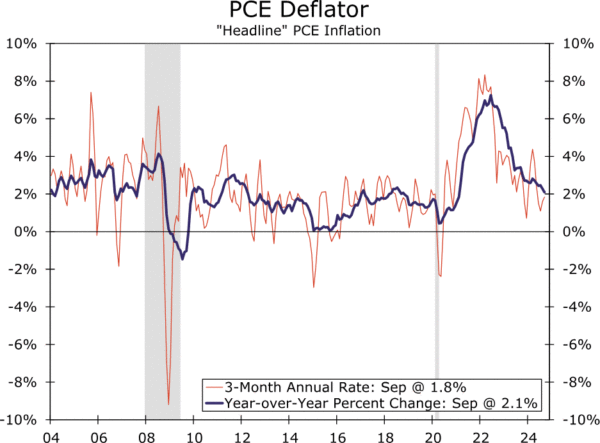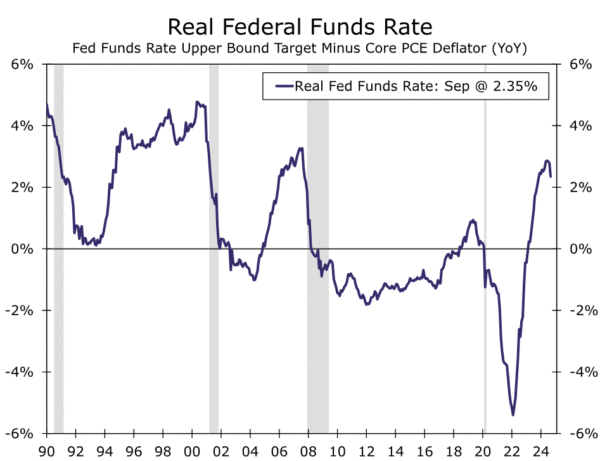Summary
- As widely expected, the FOMC cut rates by 25 bps at today’s policy meeting. The decision was unanimous.
- The Committee noted that progress has been made in returning inflation to its target of 2% and that the risks of achieving its goals of price stability and full employment are roughly balanced.
- Despite 75 bps of rate cuts since the September 18 policy meeting, the stance of monetary policy remains restrictive. That is, the real fed funds rate remains above most estimates of “neutral.” Therefore, we look for the FOMC to ease policy further at upcoming meetings.
- In our view, the FOMC will not react to potential policy changes that could be implemented by the incoming Trump administration until those policies are more fully formed. If, however, tariffs or other fiscal policies were to cause inflation to move higher next year, then we believe the nominal fed funds rate would not fall all the way toward 3%, as we had forecasted prior to the election.
Progress on Inflation and Balanced Risks Lead to Rate Cut
As widely expected, the Federal Open Market Committee (FOMC) decided at its policy meeting today to reduce the target range for the federal funds rate by 25 bps to 4.50%-4.75%. After peaking at a range of 5.25%-5.50%, the FOMC has now cut rates by 75 bps since September (chart). The decision to cut rates by 25 bps today was unanimously supported by all 12 voting members of the Committee. Federal Reserve Governor Michelle Bowman dissented at the September 18 meeting when the FOMC reduced the target range for the fed funds rate by 50 bps. Governor Bowman preferred a rate cut of only 25 bps at that meeting.
The statement that the FOMC released after its meeting today is similar to the one that it released on September 18. That is, the Committee noted in today’s statement that “inflation has made progress toward the Committee’s 2 percent objective.” In that regard, the PCE deflator, which is the Fed’s preferred measure of the rate of consumer price inflation, was up only 2.1% on a year-ago basis in September (chart). Furthermore, the FOMC judges “that the risks to achieving” its dual mandate of price stability and full employment “are roughly in balance.” Therefore, “in support of its goals” the FOMC decided to cut rates by 25 bps today.
Stance of Policy Remains Restrictive Despite Recent Rate Cuts
Recently released data show that real GDP was up at a solid rate of 2.7% on a year-ago basis in Q3-2024 and that the unemployment rate was only 4.1% in October. If the economy is doing so well, why cut rates at all? The reason is that the stance of monetary policy, as measured by the real fed funds rate (i.e., the nominal rate minus the underlying rate of inflation) is restrictive at present. Indeed, Chair Powell noted the restrictive stance of policy in his post-meeting press conference. The “neutral” real fed funds rate, which is the real interest rate that neither stimulates the economy nor restrains it, is unobservable. However, most analysts estimate that the neutral real rate is somewhat around 1%. With the real fed funds rate currently above 2% (chart), Federal Reserve policymakers apparently judged that they needed to dial back the degree of policy restraint via a cut to the nominal fed funds rate. Otherwise, they risk a significant deceleration in economic activity, which could push up the unemployment rate by more than most Fed officials would feel comfortable.
The final FOMC meeting of 2024 will be held on December 18, and our current forecast looks for another 25 bps rate cut at that meeting as the FOMC “feels” its way back toward neutral. As we noted in a recent report, however, the sharp increase in tariff rates that the incoming Trump administration may levy on many of America’s trading partners could lead inflation to move higher after their implementation. In our view, the FOMC will not make a policy decision at its upcoming meeting based on what it thinks the incoming administration may do. Rather, the Committee will wait until policies are more fully formed and their effects better understood before reacting, if appropriate, with its own response. Our most recent forecast, which was compiled before the election, looked for the FOMC to cut its target range for the fed funds rate to 3.00%-3.25% by the end of 2025. (We do not make assumptions about the outcomes of elections until the ballots are counted). But if the incoming Trump administration does indeed levy significant tariffs or adopt other inflationary policies, then we believe the fed funds rate may bottom out next year closer to 4% than to 3%.
















